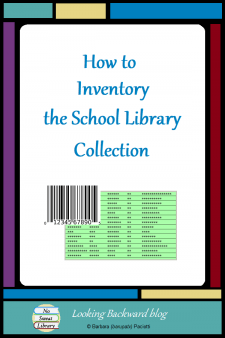 School Librarians, can we talk?
School Librarians, can we talk?
Let’s face it: our most dreaded task is having to inventory the School Library collection.
My first one was unimaginably time-consuming and tedious, but afterward I formulated a set of procedures that streamlined the process, and I can attest that inventory needn’t be the ominous undertaking that many fear.
We can better appreciate a school library inventory if we understand why it’s important for us to do it.
WHY DO A SCHOOL LIBRARY INVENTORY
I rather enjoyed doing inventory because when finished I knew exactly what was on the shelf and what was in the online catalog…and that they agreed with each other—an important consideration when dealing with students (and teachers) who insist they “returned that book” …which, occasionally, I’d find they actually had! That, then, is the most important reason for doing a physical inventory: to guarantee agreement between the physical collection and its documented status.
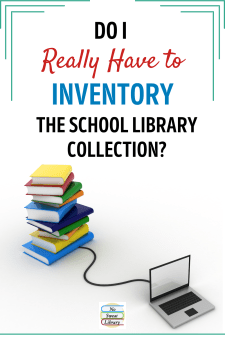 No matter why, items go missing from our collection each year. It’s very discouraging to a patron and to a School Librarian to look for a needed item that’s listed in the catalog, is supposed to be there, but just isn’t. The item may truly be missing, but it may also just be mislabeled or cataloged incorrectly—no matter how careful we try to be, human error happens. Whatever the case, an inventory allows us to reconcile discrepancies. That’s another reason to do an inventory: to correct cataloging and labeling errors between an item and its MARC record.
No matter why, items go missing from our collection each year. It’s very discouraging to a patron and to a School Librarian to look for a needed item that’s listed in the catalog, is supposed to be there, but just isn’t. The item may truly be missing, but it may also just be mislabeled or cataloged incorrectly—no matter how careful we try to be, human error happens. Whatever the case, an inventory allows us to reconcile discrepancies. That’s another reason to do an inventory: to correct cataloging and labeling errors between an item and its MARC record.
When we have consistency between catalog and collection, we will generate accurate reports from the automation system:
- A collection analysis report provides a true picture of our collection so we can weed outdated material and make purchases that develop a balanced, relevant collection. It’s also the evidence we need to request additional funding for improving the school library to meet the needs of our students and teachers.
linebreak - A loss analysis report tells us what’s really missing so we can replace important curricular materials. It also provides our yearly rate of loss which may give us the leverage we need to change library visitation policies or request a security system.
linebreak - A bibliographic and item record report reveals duplicate records and “empty” titles. If we purchase from multiple vendors, their records may not consolidate in our automation system. When we delete (for whatever reason) all copies of a title, our system may not eliminate the title record. These types of catalog entries confuse our students and frustrate us, so we want to find and correct them by aggregating multiple copies into one title and eliminating titles for which there is no item.
Finally, and not least important, we do inventory as accountability for public funds that are invested in our school library collection. We owe our taxpayers an accurate record of how we are spending their money each year, and how much the School Library is “worth.” Some states even require this type of transparency for schools by law, and we need to comply if that’s the case for us.  Moreover, each year schools and school libraries are suddenly destroyed by fire, flood, or weather. An accurate inventory of a school’s library collection is the only way to assess the catastrophic loss replacement for insurance or federal/state funding.
Moreover, each year schools and school libraries are suddenly destroyed by fire, flood, or weather. An accurate inventory of a school’s library collection is the only way to assess the catastrophic loss replacement for insurance or federal/state funding.
WHEN TO DO A SCHOOL LIBRARY INVENTORY
Unless you are fortunate enough to have permanent adult aides, the school library inventory falls on your shoulders alone. I have one suggestion to make the prospect of doing inventory less daunting: create a schedule of mini-inventories over a period of several years! It makes so much more sense to do a small selective inventory every year than to tackle a huge one every 4 or 5. Mini-inventories are quicker and easier, you’re less likely to make mistakes, you don’t have to shut down the library, and your catalog and collection have a higher degree of ongoing agreement.
This is the layout of bookcases in my school library, containing some 15,000 items. With 8 aisles of books, I inventory by aisle, both sides of one Dewey and one Fiction each year over a 4 year period. Year 5 I do Professional and equipment. With far fewer items to scan, I can complete it alone in 2 days.
My library shelving is continuous, but if your library layout isn’t conducive to my method, you could instead use a by-Dewey-number schedule. At right is one I found online from the Harlingen, TX school district.
If you’ve read about my Fiction by Subject arrangement or my Special Collections, you’ll know that this is also a great way to do mini-inventories. By choosing to do just one or two Fiction subjects or collections each year, we can spread the fiction inventory over 4 or 5 years.
HOW TO DO A SCHOOL LIBRARY INVENTORY
Here are pre-inventory tasks you’ll want to take care of:
- Repair and shelve any damaged books.
You want to be able to scan your way down your chosen section of bookshelves, knowing you have everything on the shelf that belongs there. It’s too easy to forget to scan piles of books set elsewhere.
linebreak - “Read” and weed each section before taking inventory.
It’s just so much easier to have the shelves in order before scanning barcodes, and there’s no point in tallying and reporting books that need to be cleared out of the collection. If you weed regularly, you may just need a quick look over the shelves as you read them to pull out damaged or old books. If you’ve put off weeding read my post on Weeding Dewey Books: a 6-Step Plan to simplify the task.
linebreak - Inventory all checked out items.
This is especially important when you do mini-inventories; trying to piecemeal inventory as you check-in books from the chosen inventory section is asking for errors. (If your system allows you to inventory a specific range of call numbers that are checked out, certainly do that instead of the entire collection.)
During the mini-inventory I used 3 different methods to tally the books in the chosen sections:
- Scan using an inventory tool or by attaching a barcode scanner to a laptop. Either tool records the barcodes to a spreadsheet which is then downloaded into the automation system’s inventory app. This is the quickest way to do it, but with a limited number of tools in my district I couldn’t always get one, so I used both of the following methods, too.
linebreak - Pull books onto a 2-sided bookcart, scan at the circulation desk, then return the books to the shelves. This is the hardest way to do inventory and I don’t recommend it, but I used it when students were coming in & out of the library so I didn’t have to run back & forth and forget my place in the aisle. Since cart shelves are about the same length as bookshelves, I’d fit 6 shelves of books at a time, and could complete the entire aisle in 8 trips.
linebreak - Run a Shelf List report and print out, going down the shelves, highlighting books on the shelf with one color and missing books in a different color. I know it seems old school, but this method is reasonably fast for a mini-inventory and it became my preferred method after doing enough inventories to have a well-reconciled catalog and collection. (I’d scoot leisurely down the aisle in my rolling chair.) I could catch the few cataloging errors from new purchases and since the list also had current location, I use a 3rd highlighter to mark titles of still-checked-out books and check them back in later.
Here are post-inventory tasks to complete from your inventory reports:
- Check in items that are still checked out but on the shelf. If any of these are items that students have paid for as lost, follow your school’s procedure for arranging a timely refund.
linebreak - Correct errors between labels and MARC records.
linebreak - Charge out missing books according to your school district policy and then run a report listing these missing books to reorder desired titles. (Ours were checked out to MISSING and at the end of the following school year, after allowing for reports and being found, we deleted them completely, including the bibliographic record if it was the only copy.)
linebreak - If using the Shelf List method, do a global/batch inventory of the call numbers on your shelf list after it’s otherwise cleared up!
linebreak - Record the inventory completion date on whatever you use to keep track of it, and be sure to include the mini-inventory in your next Report to Principal!
As you can see, performing a School Library inventory doesn’t have to be “the thing you hate most.” In fact, the satisfaction of knowing your collection and catalog are in order makes curating resources for projects, creating Special Collections for reading promotion, and collection development more productive and also more pleasurable. So, take a look around your School Library and decide which aisle or Dewey number most needs a mini-inventory and start the process, letting the rest go until another year.

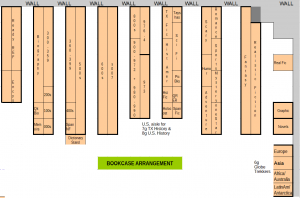
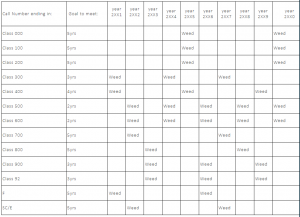
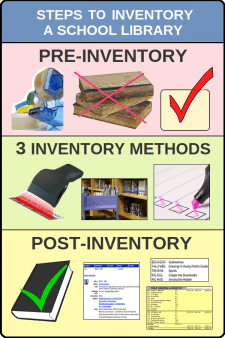


Hello Miss. P, I am a student of Library Information Technology. Currently, I am working on an information management assignment for which I chose a school library as an organization for the assignment. A friend sent me the link to your article and told me it will help me do my assignment. And it truly did. The insights of inventory, use of simple language, small break down all of it is very helpful. Thank you for this post.
Thank you, Indrani, for your kind comment. I’m so glad this article could help you with your assignment. Best wishes to your continued schooling.
BrP